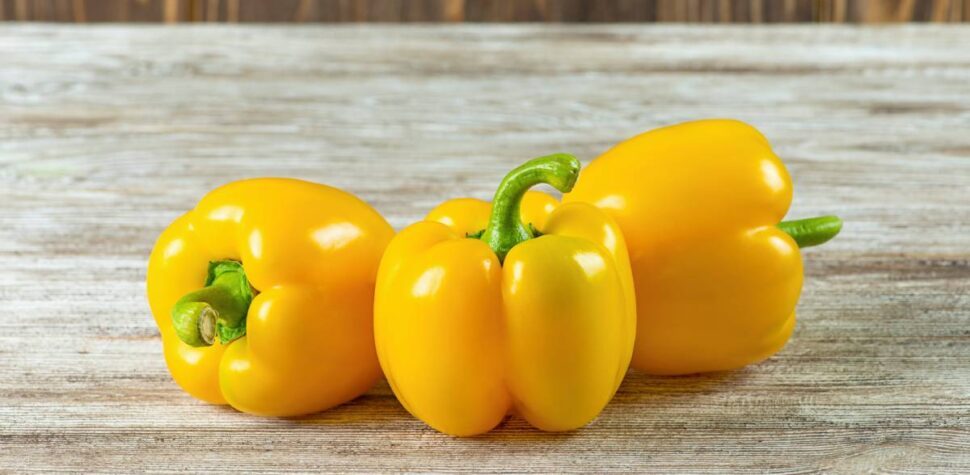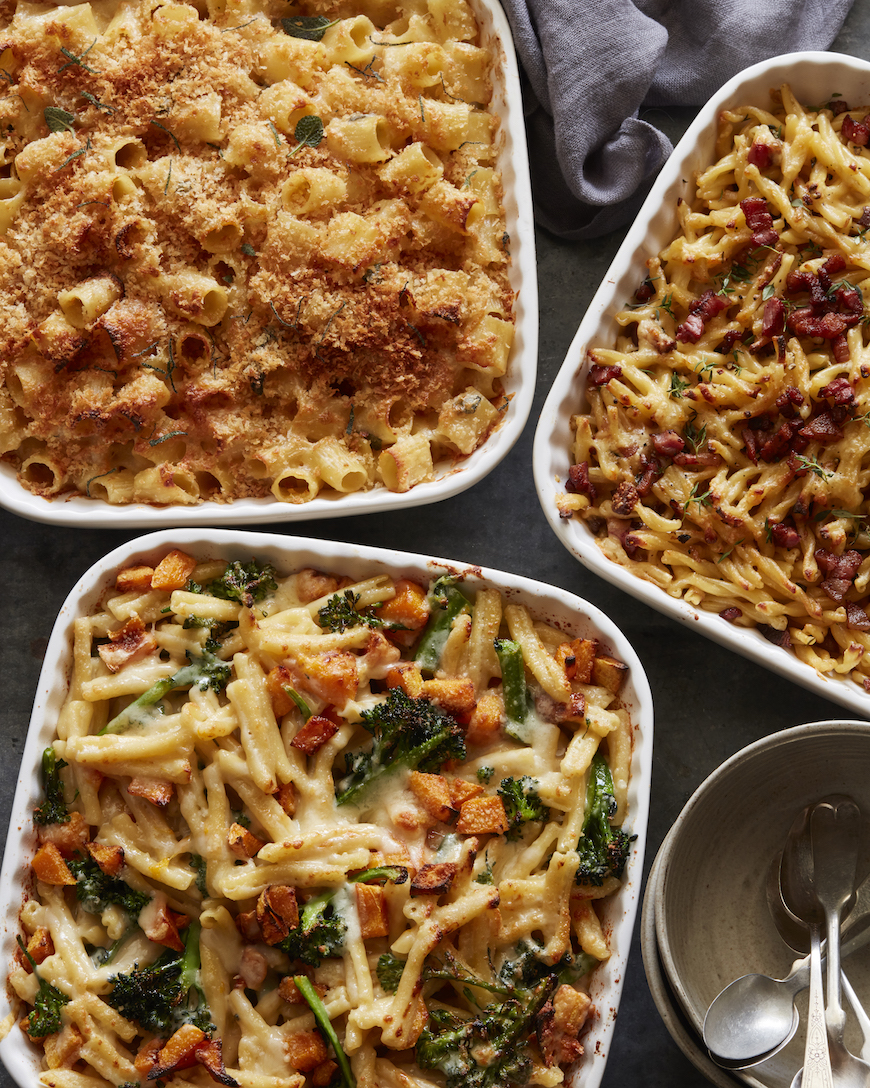Introducing more yellow vegetables to your diet adds a pop of colour to your plate and provides essential vitamins and minerals. Here are 10 of the best yellow vegetables to add to your diet.
Yellow bell peppers
Yellow bell peppers are a colourful and versatile vegetable and are an excellent addition to any dish. They have a slightly sweeter taste than their green counterparts and are an excellent source of vitamins A and C. They are also low in calories and high in fibre.
To choose the best yellow bell peppers, look for firm ones with smooth, shiny skin. Avoid any soft peppers with wrinkled skin, as this is a sign of ageing.
When it comes to preparing yellow bell peppers, the possibilities are endless. They can be eaten raw in salads, sliced up as a snack, or cooked in various ways, including grilling, roasting and sautéing. One popular way to prepare yellow bell peppers is to stuff them with rice, vegetables and ground meat for a flavourful and healthy meal.
If you’re looking for inspiration, try making a yellow bell pepper stir-fry with some garlic and ginger or slicing them into strips and roasting them with olive oil and herbs for a quick and easy side dish. You can also use them as a topping for pizza or chop them up and add them to omelettes or frittatas for a delicious and nutritious breakfast.
Yellow summer squash
Yellow summer squash is a nutritious and delicious vegetable that is perfect for the summer season. As a member of the gourd family, it has a mild and slightly sweet flavour and is an excellent source of vitamins A and C, potassium, magnesium and fibre.
When selecting yellow summer squash, it’s best to look for those that are firm and heavy for their size, with bright yellow skin free from blemishes or soft spots. Avoid squash that is too large or has a dull or wrinkled appearance, as this can indicate that it is past its prime.
Yellow summer squash is a versatile ingredient that can be prepared in various ways. One simple and delicious way is to slice it into rounds and sauté it in olive oil with garlic and herbs for a quick and easy side dish. Another popular method is grilling it on its own or skewering it with other vegetables for a tasty and healthy summer barbecue option.
For the more adventurous cook, yellow summer squash can be used to make soup with chicken stock and herbs or as a base for vegetable lasagne. It can also be used to make a savoury and satisfying frittata or quiche.
To learn more about yellow summer squash’s benefits and culinary possibilities, read our article on seasonal August food.
Yellow cherry tomatoes
Most people are familiar with the classic red variety. But have you ever tried yellow cherry tomatoes? These little gems may be small, but they pack a big flavour punch. These tomatoes are bright yellow and sure to catch your eye. Their thin skin encases a juicy interior that bursts with sweetness and a slight tanginess. They are also a good source of vitamins A and C.
One of the most popular varieties of yellow cherry tomatoes is ‘Sungold’. This tomato has a tropical fruit-like flavour that is sweet and tangy at the same time. Another popular variety is ‘Yellow Pear’, which has a mild, slightly tangy flavour. Both varieties are easy to grow and can be grown in containers, making them perfect for those with limited space.
In the kitchen, yellow cherry tomatoes are incredibly versatile. Their bright colour adds a pop of visual interest to any dish. They are great for snacking, adding to salads and as a topping for pizzas and pasta dishes. They also work well in roasted vegetable medleys.
Give them a try and see why they’ve become popular among food lovers everywhere.
Yellow beetroots or golden beets
Yellow beetroots are a colourful and unique variety of beetroot that is becoming increasingly popular in the culinary world. Unlike their red counterparts, yellow beetroots have a bright and sunny exterior. The flesh of the beetroot is a pale yellow colour that can be slightly milder in flavour than traditional red beetroots.
Yellow beetroots are tasty, nutritious, and packed with fibre, folate and potassium. These versatile vegetables can be enjoyed raw, roasted, pickled, or grated into salads and are a great way to add colour and flavour to a wide range of dishes. To incorporate yellow beets into your diet, try roasting them with olive oil and herbs, then tossing them into a salad with goat’s cheese and walnuts.
Overall, yellow beetroots are an excellent choice for those looking to add variety to their vegetable garden or spice up their plate with a pop of colour and added nutritional benefits.
Yellow carrots
Yellow carrots are a unique and tasty variety explicitly grown for their sweet and earthy flavour. They have a firm, crunchy texture and are often sweeter than orange carrots. The flavour profile of yellow carrots is described as earthy sweet with notes of celery and parsley. In addition to their unique taste, yellow carrots are also highly nutritious. They’re an excellent source of beta-carotene, a nutrient essential for maintaining healthy eyesight. Yellow carrots are also a good source of fibre, which is vital for maintaining digestive health and promoting feelings of fullness.
There are many ways to incorporate yellow carrots into your meals. They can be eaten raw as a snack or sliced into salads. Roasting yellow carrots is another great way to bring out their natural sweetness, and they pair well with honey and thyme. Yellow carrots also make a delicious addition to stir-fries, soups, stews and other vegetable dishes.
Yellow potatoes
The increasing popularity of yellow potatoes demonstrates that white potatoes are not the only option available. Yellow potatoes are favoured over their creamy or starchy counterparts in many regions worldwide. They tend to be sweeter, which allows cooks to use smaller amounts of flavouring. Additionally, they are often waxy instead of starchy, resulting in fewer total carbohydrates.
You should avoid potatoes with numerous sprouts or eyes. If the potatoes have small eyes, they should be almost pink. Potatoes that appear green have been exposed to too much air or stored improperly and should not be purchased. The skin of the potatoes should be a light brown colour without any visible bruises or large markings.
Yellow potatoes are a popular substitute for white potatoes in many recipes. They have a softer skin that is easier to peel, making them versatile in many dishes, such as mashed potatoes and potato salad, or as a key ingredient in au gratin dishes. A visually appealing way to use yellow potatoes is, for example, to combine them with red potatoes to create a colourful potato salad or roasted dish with delightful flavours.
Yellow wax beans
Wax beans, also known as yellow beans or butter beans, are a variety of green beans with a pale yellow colour. They can be found in both dwarf and bush varieties at grocery shops and farmers’ markets. Wax and green beans share a similar structure, texture and taste; the sole difference is the absence of chlorophyll, which is responsible for the green colour of green beans. Despite their distinct appearance, they offer similar nutrients, primarily calcium and vitamin A, and can be cooked interchangeably.
Yellow wax beans have a pale cornflower-coloured, stringless pod with a translucent yellow flesh that clings tightly to its petit lime green legumes inside its shell. The term ‘wax’ might indicate an unappealing texture, but yellow bean varieties have a matte or satin finish instead. Ideally picked young, yellow wax beans possess a crispy, succulent, tender and firm texture with a mellow grassy sweet and nutty flavour.
To select the finest wax beans, ensure they are free of spots and have a brittle snap. Once you’re ready to cook them, cut the stem ends and wash the beans with cold water. Wax beans are versatile and can be eaten raw or cooked. For a swift and simple salad, steam the beans and toss them in a vinaigrette, then sprinkle fresh breadcrumbs on top. You could also roast them with a bit of olive oil or blanch them briefly and coat them with butter. In salads, they combine well with cooked tuna or salmon or can be served with a creamy herb dip.
Yellow cauliflower
Yellow cauliflower is a member of the cruciferous vegetable family, with a similar mild, sweet, and nutty flavour and texture to white cauliflower. However, the difference between them lies in their colour, which slightly affects their nutritional value. As a genetic mutation, yellow cauliflower contains more beta-carotene than white cauliflower, making it an excellent source of this essential nutrient. In fact, this vegetable is highly nutritious, containing almost every necessary vitamin and mineral, and is high in fibre. Its intense yellow hue adds visual appeal to its nutritional value when cooked.
Yellow cauliflower can be used in any recipe that calls for white cauliflower, including steaming, roasting, frying or pickling. You can also puree boiled or steamed yellow cauliflower and add it to soups, sauces and casseroles. It pairs well with cardamom, cumin, curry, garlic, robust cheeses, Brussels sprouts and onions. Remember to use the cauliflower within a few days of purchasing and rinse it immediately before use.
Yellow aubergine
Aubergines are commonly associated with large, waxy, purple fruits, but not all aubergine varieties produce this iconic colour. Aubergine fruits can range from pale green to a deep purple that appears black, shades of yellow and even white.
One example of a yellow aubergine is a small, round or oval fruit with a diameter averaging 2-5cm. When young, the outer skin is smooth and white but becomes yellow when mature. Despite their similar appearance to other aubergine varieties, yellow aubergines have a different flavour profile. They are dense, crunchy, and bitter, lacking the mild, earthy and sweet flavours of larger, soft, and fleshy aubergine varieties. They are a good source of dietary fibre, calcium, phosphorous, potassium and manganese and contain some vitamins A and C.
Yellow aubergines are most suitable for sautéing, frying and roasting. Due to their naturally bitter taste, removing the seeds and soaking the flesh in water is recommended to reduce its sour flavour. A popular way to prepare yellow aubergines is by slicing them and sautéing them in coconut milk-based curries. They can also be diced and stir-fried with chillies and used interchangeably with or alongside the more common green variety of Thai baby aubergine.
Yellow corn
Corn has long been considered a good source of food and fuel. Corn or maise, a grain crop, is a staple food in many parts of the world. There are many varieties of corn, but white and yellow corn are the most common.
Yellow corn, like white corn, is a variety of sweet corn and can be considered a grain, a fruit or a vegetable, depending on its maturity and use. Yellow corn also contains plenty of water and sugar, giving it a sweet flavour, and is often steamed, roasted, or grilled before eating. It is also used as a sweetener in some foods and beverages.
Yellow corn is wrapped in tightly bound lime-hued husks with silks and a tassel extending from the tip. The yellow kernels are packed in tight, almost uniform rows. A single ear of corn can contain up to 400 kernels. Whole corn contains fibre and vitamin C, B vitamins, magnesium and potassium, and thiamine. Furthermore, the fibre in corn may provide a number of health benefits.
Yellow corn can be grilled, boiled, or roasted, perfect for salads, soups, or as a side dish. To add a burst of flavour to your meals, boil yellow corn on the cob and season it with chilli flakes, lime juice and salt.













